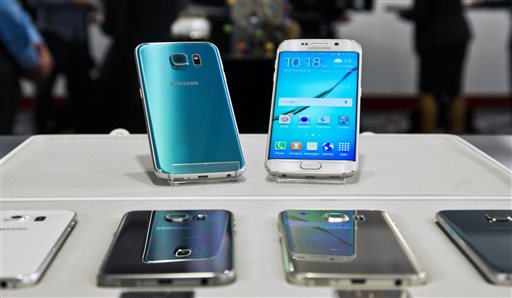Samsung hopes to reverse dimming fortunes with Galaxy S6

The new Samsung phones, Galaxy S6, top left, and Galaxy S6 Edge, top right, which were officially unveiled on March 1, 2015 on the eve of the Mobile World Congress wireless show in Barcelona, Spain. AP
SEOUL, South Korea — When Samsung dubbed development of its latest smartphones “Project Zero,” it was sounding a note of desperation as sales tumbled and it lost pole position in the crucial Chinese market to rivals Xiaomi and Apple.
The results of its overhaul, the flagship Galaxy S6 smartphone and the S6 Edge, go on sale in 20 countries on Friday. Samsung, which said “Project Zero” signified starting from scratch, is hoping a revamped design, a more intuitive interface and less clutter will help claw back lost market share.
They are Samsung’s first flagship products to hit shelves since its mobile business suffered a 40 percent slump in earnings last year. It retained its position as the world’s top selling smartphone maker last year, but was the only top-five smartphone maker to sell fewer phones. In the final quarter of 2014 it slipped marginally behind Apple in sales, according to Gartner, a market research firm.
Consumers and media were head over heels over Apple’s new iPhones with bigger screens, while the plastic foundation of Samsung’s Galaxy models was increasingly derided as looking cheap. In China, Samsung was unprepared for the sudden popularity of cheaper smartphones made by local manufacturer Xiaomi.
As part of its rethink, Samsung replaced executives in its mobile team while keeping the CEO and streamlined its various moving parts. So far the changes seem to be paying off.
Pre-launch reviews praised Samsung’s decision to ditch a plastic body and replace it with glass and metal for the new phones. The company also seemed to finally heed persistent complaints that its phones are too complicated and it trimmed the dauntingly long list of apps that cluttered screens.
The Galaxy S6 is expected to set a sales record for the Galaxy series of phones, Lee Sang-chul, head of mobile marketing at Samsung, told reporters. Meeting demand for the Galaxy S6 Edge, which features a screen that curves halfway down the sides, will be difficult because of a limited supply of the curved screens, CEO Shin Jong-kyun said.
Analysts said the Galaxy S6 and the S6 Edge will help Samsung regain some of its lost ground in China, the world’s largest smartphone market, but probably won’t propel it back to No. 1 nor outshine Apple in the high-end market.
Xiaohan Tay, a senior market analyst at market research firm IDC, said the cachet of the iPhone is its key selling point over Samsung in China.
“Apple is seen as a premium and luxury brand by Chinese consumers, and they are willing to pay a premium price for the iPhone,” Tay said. “There are even some less-well-to-do consumers who will save up and spend a few months of their salary just on an iPhone.”
“Samsung does not have that brand image in the eyes of Chinese consumers yet,” she said.
But Samsung appears confident that consumers will splurge.
In South Korea, the prices for the Galaxy S6 and the S6 Edge begin at $791 and $900, more expensive than their predecessors released in 2014. It plans to announce prices for China next week, when the phone will be launched there on April 17 but they are not expected to be much different.
Peter Yu, managing director at BNP Paribas Securities Korea Co., said price probably won’t be a significant barrier in China. Mobile carriers will likely give generous subsidies to buyers of the S6 because there are few rival phone launches during Spring.
Yu thinks a fair number of people will switch to Samsung’s new phones, both from other Android phones and Apple’s iPhones.
“In China, I don’t think Apple’s ecosystem is as strong as in the U.S.,” he said. “They are customers less bound by Apple’s ecosystem.”
Samsung was the largest smartphone seller in China when competition from local manufacturers was limited. That changed last year as Lenovo, Huawei and Xiaomi released cheaper alternatives to high-end phones while Apple gained share in the premium market.
Market research firm Canalys said Apple became the No. 1 smartphone maker in China in the fourth quarter followed by Xiaomi, putting Samsung at third.
For Apple, the revamped Samsung phones, which include enhanced hardware features such as the Galaxy S6’s camera and the curve in the S6 Edge, might be less of a threat than they are to Android-based phones.
“It will take more share from other Android competitors than it will Apple,” Tom Kang, research director at Counterpoint Technology Market Research, said in a report.
“The iPhone 6 and 6 Plus had absorbed most of the budgets of the premium users and the cycle is not going to be broken for the next 24 months for these users.”